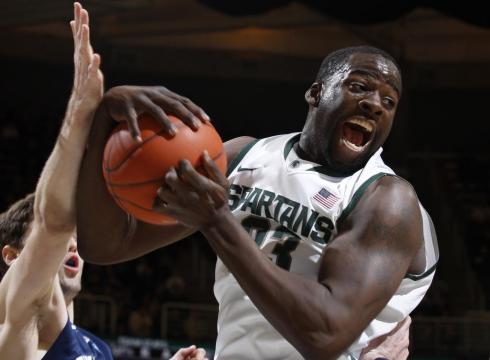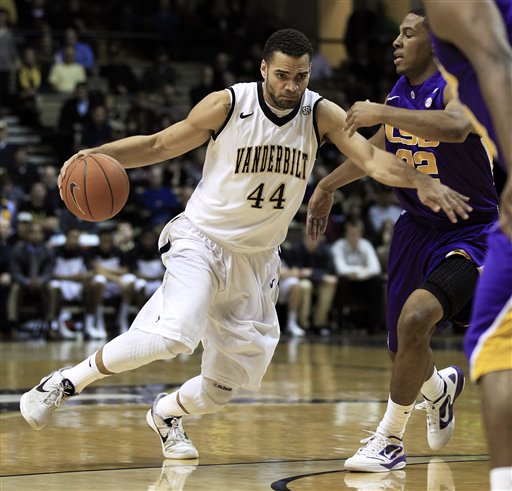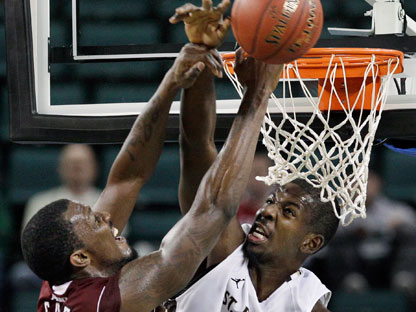Bracket Prep: Michigan State, Florida State, Vanderbilt, St. Bonaventure, Long Beach State, & New Mexico State
Posted by EJacoby on March 11th, 2012Selection Sunday is here! We’ve been providing you with summaries of every automatic bid to the NCAA Tournament, and this post concludes all of the conference tourney winners. Big Ten, SEC, ACC, A-10, Big West, and WAC were the last ones to complete their championships. Here’s everything you need to know.
Michigan State
- Big Ten Champion (27-7, 16-5)
- RPI/Pomeroy/Sagarin = #4/#3/#3
- Adjusted Scoring Margin = +17.3
- Likely NCAA Seed: #1
Three Bruce Pearls of Wisdom.
- After winning the Big Ten Tournament, expect Michigan State to steal the last #1 seed in the NCAA Tournament. There’s nothing that this team hasn’t done to deserve the top line. 27-7 against the #1 strength of schedule, co-champion of the best conference in the country, and Big Ten Champions. This is a classic Tom Izzo team that’s ferocious on the boards and executes efficiently on both offense and defense. The Spartans run through their Big Ten Player of the Year, but this is a deep team that relies on many contributors in different areas. A late season ACL injury to blossoming freshman forward Branden Dawson was horrible news and is potentially devastating. But Dawson was still not much of an offensive factor and the team won the Big Ten Tournament without him, showing an ability to adapt.
- Draymond Green is the Big Ten Player of the Year who does everything that you want in a senior star leader. 16.2 points, 10.4 rebounds, 3.6 assists, 1.5 steals, and 1.0 blocks per game is what Green provides. The 45% field goal percentage doesn’t look great until you realize that Green does much of his work on the perimeter, including hitting the most three-pointers on the team. The rest of this team is loaded with strong athletes and defenders, from the interior duo of Derrick Nix and Adriean Payne to the perimeter players Keith Appling and Brandon Wood, and beyond to the reserves. Appling is crucial to this team as the playmaking point guard with explosive agility to make plays for his teammates and himself.
- Most things in March Madness are unpredictable, but one of the few guarantees is that Tom Izzo’s teams will play their best basketball in the NCAA Tournament. This Izzo team is loaded and ready to dance with as difficult a combination to beat as nearly anyone in the country. A +17.3 adjusted scoring margin is the fourth best in the nation, led my MSU’s elite defense. The Spartans allow just 37.7% defensive field goal shooting, the second best in the land. Their 89.9 defensive efficiency also ranks in the top 10. Throw in their own 47.7% field goal shooting, and this team’s shooting percentage disparity is fantastic, which is always a top formula for success. Their 55.2% rebound percentage is top 10 in the nation, as well. The numbers look great for Michigan State. But this team just lost its best athlete to the ACL injury and it doesn’t have the amount of elite scorers that a usual #1 seed does. Instead, this team is so efficient defensively that it will be difficult to knock off. Teams that gave Michigan State trouble were those that caught fire from the outside while holding their own defensively, like Indiana. Expect an awesome clash of styles between MSU and its opponent in a Sweet Sixteen matchup, if it can avoid an upset from the 8-9 seed, or 10-7 seed if it receives a #2 seed.
Florida State
- ACC Champion (24-9, 15-4)
- RPI/Pomeroy/Sagarin = #17/#23/#21
- Adjusted Scoring Margin = +11.2
- Likely NCAA Seed: #3/#4
Three Bruce Pearls of Wisdom –
- Florida State went 8-5 in its non-conference season, including getting swept by the Ivy League (Harvard and Princeton). But that seems like ages ago, as the Seminoles have improved dramatically and accrued more great wins than almost any team in America since the new year. They swept North Carolina and Virginia and beat Duke two out of three times. FSU remains a bit of an enigma, though, as it did lose at Boston College (RPI #236) and nearly lost at home to Virginia Tech, as well (RPI #118). This team runs into trouble when it’s not hitting jump shots, but it has shown the capability time and time again to beat the best teams in the country thanks to a fantastic team defense with great size and length. FSU just might earn itself a #3 seed after winning the ACC Tournament.
- Florida State is one of the most unique teams in the country because the offense is so unpredictable. Michael Snaer is the leading scorer at 14.4 PPG and he’s made a name for himself as a clutch late-game playmaker, hitting two game-winning threes this season. But Snaer is far from a consistent scorer, often times living and dying by the three. He’s playing his best ball of the season, though, right now, posting three straight 16+ scoring nights in the ACC Tourney. Ian Miller‘s expected development (11.0 PPG) into a playmaking guard has been huge, to give FSU two go-to guards. Luke Loucks and Deividas Dulkys are both streaky shooters that simply either have it or don’t in any given game. Bernard James, Xavier Gibson, and Okaro White are terrific interior defenders with their elite athleticism and shot-block ability.
- The weapons are there for FSU to beat nearly anyone. Leonard Hamilton‘s team has perimeter shooting, playmaking, interior threats, and strong defense. But execution is always the issue. The Seminoles have a 90.8 defensive efficiency that ranks 12th in the country, as well as a defensive field goal percentage of 38.0%, good for fourth nationally. They rack up blocks (5.9 per game) and steals (7.7 per game) at a strong rate with all of their long defenders. But this is an average offensive team that has struggled with turnovers all season long. Its 0.73 assist-to-turnover ratio is awful for an elite team, ranking 319th in the country. If FSU wants to make a serious push for the Final Four, it needs to be more efficient offensively and have its guards make better decisions with the ball. It should avoid an upset early on with a strong seed, but starting with the round of 32 this could be a vulnerable team. A matchup with a team like New Mexico or Temple, strong defensive teams with good guards, could spell trouble. A matchup with a team like Indiana would be a fascinating clash of styles, as well. We’ll see if FSU’s defense can power it through to the Sweet Sixteen or deeper.
Vanderbilt
- SEC Champion (24-10, 13-6)
- RPI/Pomeroy/Sagarin = #22/#17/#22
- Adjusted Scoring Margin = +11.5
- Likely NCAA Seed: #4/#5
Three Bruce Pearls of Wisdom –
- Here we have another enigmatic team that seems to have the ability to execute and beat top teams, but also the limited defensive upside that allows it to be an upset candidate. Vanderbilt, of course, has indeed fallen victim to early upsets in back-to-back seasons. In fact, since 2008 the Commodores have made the NCAA Tournament in three out of four years, been a #5 seed or better, and been upset in the first round every time. Will this year be much of the same? Vandy is coming off defeating #1 Kentucky in the SEC championship, and the ‘Dores are loaded with veterans who know what it feels like to bow out early. It would be devastating if they got upset early once again, and it would be hard to envision. This should be the year that Kevin Stallings‘ team advances and has a chance for the Sweet Sixteen and beyond.
- Junior John Jenkins led the SEC in scoring with 20.0 per game and is joined by four seniors in the starting lineup. Sixth man Steve Tchiengang is also a senior. Only Jeffrey Taylor joins Jenkins in double-figure scoring, but Festus Ezeli, Brad Tinsley, and Lance Goulbourne are all capable of scoring in double figures. Any way you break it down, Jenkins is the best outside shooter in college basketball (126 three-point makes, 45%), and his teammate Taylor is one of the most versatile forwards around. The question is who else is able to step up on a given night, and after the six upperclassmen there is a serious lack of depth on the team. Underclassmen Rod Odom, Dai-Jon Parker, and Kedren Johnson have shown flashes of ability but are all tough to rely on at this point.
- For such a veteran-laden team, the Commodores are surprisingly inconsistent and unpredictable. Only Jenkins and Taylor have been consistent offensively all year long. Ezeli is the best NBA prospect and athlete on the team, but he dealt with an injury for the early part of the season and has not emerged as much of a dominant big man as expected. Defensively is where the ‘Dores are also a major question mark. Ezeli, Goulbourne, and Tchiengang are all strong interior defenders but Tinsley and Jenkins are weak on the perimeter. Their defensive efficiency of 97.7 does not crack the top 100 in the country, and a 42.2% defensive field-goal percentage is also just average. They don’t get many steals per game to lead to transition opportunities. But Vandy remains a dangerous team because of the talented veterans on the roster. Jenkins can fill it up in a hurry and they seem to be a rhythm team; opponents do not want to see them get into that rhythm. A team like Long Beach State or Seton Hall would be a scary first-round opponent, but Vandy should avoid the first-round upset if it receives a #4 seed. From there, it’s all about which Vanderbilt team shows up.
St. Bonaventure
- Atlantic 10 Champion (20-11, 13-6)
- RPI/Pomeroy/Sagarin = #78/#59/#70
- Adjusted Scoring Margin = +5.8
- Likely NCAA Seed: #13/#14
Three Bruce Pearls of Wisdom –
- The Bonnies were an NCAA bid stealer after winning the A-10 Tournament despite not being on the bubble. But that doesn’t mean this team isn’t dangerous in the postseason. The Bonnies have a star forward and are a strong rebounding team that will be a pesky out in the postseason. This program has been to just one NCAA Tournament since 1980, which came in 2000. St. Bonaventure is back in and hopes to ride its A-10 Player of the Year to a postseason win.
- Andrew Nicholson, the conference Player of the Year, had his very best game in the Atlantic 10 finals on Sunday. Putting up 26 points, 14 rebounds, and 8 blocks, Nicholson was a force on both ends and will try to repeat this kind of performance next week in the first round. He averaged 18.2 points, 8.3 rebounds, and 1.8 blocks per game during the regular season on 57% shooting. The question is where the Bonnies turn after that, with just one other player (Demetrius Conger) in double figures. Nobody on this team shoots the three very well, but their 76% team free-throw percentage is one of the best in the country.
- St. Bonaventure wins when it converts efficient offense going inside-out through Nicholson. A 107.2 offensive efficiency ranked 70th in the country, and a 45.4% field goal percentage is similar in terms of relative ranking. The strong rebound percentage of 53.3% leaves St. Bonaventure in the top 35 nationally. The problem comes from the perimeter and whether or not this team can hit enough shots to stay in a game against an elite team. They will need some threes to go down if they want to beat a #4-seed kind of team in round one. A matchup with a team that doesn’t have the personnel to stop Nicholson one-on-one will be what the Bonnies hope for, but that usually is not the weakness of a high seed. If it somehow matched up with a team like Murray State, that’s this team’s best case scenario.
Long Beach State
- Big West Champion (25-8, 18-1)
- RPI/Pomeroy/Sagarin = #39/#35/#41
- Adjusted Scoring Margin = +9.6
- Likely NCAA Seed: #11/#12
Three Bruce Pearls of Wisdom –
- Don’t sleep on this team because of its overall record of 25-8. Eight losses might seem like a lot for a really good mid-major, but Long Beach State truly challenged itself in the non-conference, sporting one of the toughest November/December schedules in the country. The murderer’s row that head coach Dan Monson set up for his team included roadies to Pitt, San Diego State, Kansas, Louisville, and North Carolina, as well as an appearance in the Diamond Head Classic, where they played Xavier, Kansas State and Auburn. Monson’s team went 3-5 versus that group and they were particularly competitive in the games against the toughest teams (UNC, SDSU, Louisville, and Kansas). Against, for example, a Murray State schedule, the 49ers would likely have a similar record.
- The team’s heart and soul resides in its 5’10”, 175-pound bundle of energy known as Casper Ware. He’s no apparition, though, as the USBWA District IX Player of the Year (17.4 PPG) and two-time Big West POY is flanked by a corps of senior teammates who have played and won a bunch of games together in their four seasons on the Beach. Larry Anderson has proven a capable scorer from the wing (he missed the Big West Tourney, but should be back next week) at 14.0 PPG, while T.J. Robinson does the dirty work needed inside (12.0 PPG/10.1 RPG). Like many mid-majors, this group has been through the wars together over several seasons and finally broke through to win its conference tournament on Saturday. They are locked, loaded, and dangerous for any high seed that overlooks them.
- The Beach has a bit of a reputation as a high-scoring team that doesn’t play defense, but that’s not entirely true. They can certainly put points on the board, as 80 in Allen Fieldhouse attests, but they also turn teams over (14.5 per game) and use their potent fast break attack to convert those opportunities. They do not have a lot of depth, so foul trouble to Robinson inside or Ware on the perimeter could be especially devastating. The type of team that would give Long Beach trouble would be a ball-control team that doesn’t easily let them get out on the break. We’re thinking about a Wisconsin or even a Temple here. On the other hand, the type of team that would have LBSU and Monson salivating are teams like Florida , Indiana or Vanderbilt. Long Beach would love to get into a shootout with any of those three squads.
New Mexico State
- WAC Champion (26-9, 13-4)
- RPI/Pomeroy/Sagarin = #66/#62/#62
- Adjusted Scoring Margin = +9.4
- Likely NCAA Seed: #13/#14
Three Bruce Pearls of Wisdom –
- New Mexico State is a tough team to figure out. It finished second behind Nevada in the WAC standings (three full games back), but it managed to beat rival New Mexico in the Pit before losing to the Lobos in the return game at home. The team isn’t particularly explosive on offense or sticky on defense, but it has won nine of 10 games and did not receive so much as a challenge from anybody in the WAC Tournament. Marvin Menzies has his team back into the NCAA Tournament for the second time in three seasons.
- The Aggies will go as far as senior star Wendell McKines (18.8 PPG, 10.8 RPG) takes them. The 6’6″ forward led the WAC in both scoring and rebounding this season, and when New Mexico State is at its best, he’s dominating the block on both ends of the floor. Michigan State beat him up into a 1-8 shooting, 7/7 performance two years ago, so it’ll be important to watch NMSU’s first round opponent to determine if it can out-size and out-tough one of the best little big men there is in college basketball this season.
- To that end, New Mexico State will be a dangerous team against a higher seed this coming week. Menzies relies on an experienced group of mostly juniors and seniors who have been through the wars together for years. If they come up against a team that doesn’t have dominant interior play — like Louisville or perhaps Michigan — the Aggies will have a chance to let McKines do his thing and position themselves for the big upset. They struggle in stopping teams themselves so they certainly do not want to go up against an offensive juggernaut either.
















































